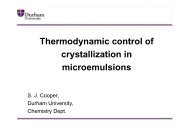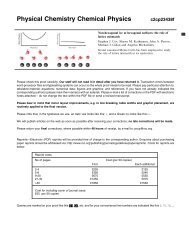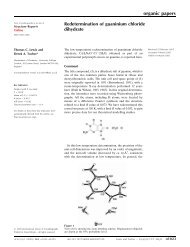ADVANCED USERS DMACRYS & NEIGHCRYS manual Manual ...
ADVANCED USERS DMACRYS & NEIGHCRYS manual Manual ...
ADVANCED USERS DMACRYS & NEIGHCRYS manual Manual ...
You also want an ePaper? Increase the reach of your titles
YUMPU automatically turns print PDFs into web optimized ePapers that Google loves.
The lattice vectors are always printed by default. They are printed in rows, with the x, y, z components of<br />
each lattice vector in each row. If PRIN LATT MPRINT with MPRINT=1 is used, the reciprocal lattice<br />
vectors are also printed, again in rows.<br />
START OF LATTICE VECTOR PROCESSING.<br />
THE LATTICE VECTORS ARE AS FOLLOWS.<br />
XLAT(1,1) XLAT(2,1) XLAT(3,1)<br />
XLAT(1,2) XLAT(2,2) XLAT(3,2)<br />
XLAT(1,3) XLAT(2,3) XLAT(3,3)<br />
Example output<br />
START OF LATTICE VECTOR PROCESSING.<br />
THE LATTICE VECTORS ARE AS FOLLOWS.<br />
1.409217537894501 0.000000000000000 0.000000000000000<br />
0.000000000000000 1.448504935925801 0.000000000000000<br />
0.000000000000000 0.000000000000000 1.000000000000001<br />
Error messages<br />
ERROR - lattice vectors not defined before crystal basis.<br />
This is a fatal error. The program decided that the lattice vectors are coplanar by working out the volume of<br />
the unit cell, which is equal to the determinant of the lattice vector matrix. This is tested to see if it is greater<br />
than ACCLAT (see ACCU directive).<br />
Error - Invalid format for F variable<br />
A fatal error, there is a format error in one of the lattice vector input records.<br />
3.3.2 BASIS ATOM INPUT<br />
Operands<br />
None<br />
BASI<br />
The BASI directive instructs the program to call the basis atom input routine. Usually the calculations<br />
described below will be carried out using the pre-processor <strong>NEIGHCRYS</strong>. This reads in further records,<br />
which have one of three possible formats<br />
Card format A15 3F < I ><br />
Long atom label Atom coordinates Optional molecule<br />
number<br />
Card format A 3F<br />
CENT<br />
Point group origin<br />
Card format<br />
A<br />
ENDS<br />
Only one CENT and ENDS record is permitted. The CENT record defines the basis origin. This record is<br />
not required for <strong>DMACRYS</strong>, it may be omitted, in which case the basis origin is taken as the point 0.0 0.0<br />
0.0. The ENDS record must be the last record, and instructs the subroutine to return to the main menu of<br />
directives.<br />
There may be any number of atom records up to a maximum of MAXBAS (this includes the CENT record if<br />
present). The long atom label consists of an A15 field made up as follows. The first two characters are the<br />
element type and make the element label. Where an element has only 1 letter has an underscore is used as<br />
the second character. The third and fourth characters denote the type of repulsion-dispersion potential, for<br />
example where the potential includes different terms for different types of hydrogen atom. The first four<br />
characters together make up the species label defining a unique element and potential type. The fifth<br />
character is _ or I, where I denotes the atom is part of an inverted molecule. The sixth to tenth characters<br />
number the atoms, where equivalent atoms in different molecules have the same number. Where the atom<br />
number is shorter than 5 digits long, the remaining characters are filled with the underscore symbol. The<br />
number starts from the left. The first 10 characters make up the short atom label. The long atom label<br />
comprises the short atom label and 5 further characters denoting the number of the atom in the entire unit<br />
cell.<br />
10







